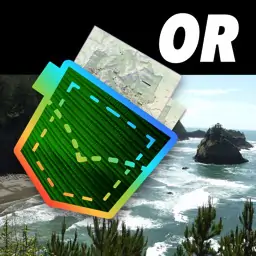Whale WatchingOregon State Parks |
Brochure about Whale Watching at the Oregon Coast. Published by Oregon State Parks.
featured in
| Oregon Pocket Maps |  |
Oregon Coast
Whale Watching
W
hale watching is one of the most popular
activities on the coast, enjoyed by tens of
thousands of visitors per year. Oregon has more
than two dozen excellent whale watching spots
on the coast; many are in or near state parks.
When is the best time
to see whales?
Park staff are ready to answer your
questions and help you spot Gray whales
at the Whale Watching Center in Depoe
Bay. Perched on the seawall with expansive
ocean views, the center is a perfect spot to
see whales.
Gray whales are the most commonly sighted
whales on the coast. Their seasonal migration
patterns bring more than 20,000 of them past
the coast each year.
In the winter, from mid-December through
mid-January, the whales travel south to the
warm lagoons of Baja Mexico.
Spring watching begins with a surge in late
March as the gray whales travel north to
Alaska. Whales are northbound through May.
About 200 Gray whales remain in Oregon’s
coastal waters every year. Summer and fall
you may see them feeding closer to shore. The
central coast is a hot-spot for whales from May
through October.
Whale Watch Week
Oregon State Parks celebrates the migrations
twice per year with Whale Watch Week
during late December and late March.
Volunteers are stationed at more than 20 of
the best whale watching sites along the coast,
ready to help visitors spot whales and offer
fun facts about the marine mammals. For
Whale Watch Week dates and locations, visit
whalespoken.org.
Hours: Daily, 10am – 4pm
(call ahead for winter hours)
Address: 119 SW Hwy. 101, Depoe Bay
Information: 541-765-3304
Be a volunteer
The Whale Watching Spoken Here program
places volunteers at great whale watching sites
during the two official whale watch weeks.
Volunteers help visitors see and learn about
migrating and resident Gray whales. Are
whales your passion, too?
Visit whalespoken.org to sign up.
oregonstateparks.org
Whale Watch Week, Dec. 2018.
Printed on Recycled Paper
This brochure is available in alternative formats on request.
Write to OPRD, 725 Summer St. NE, Suite C, Salem, OR 97301;
or call 1-800-551-6949 (for the hearing impaired 1-800-735-2900).
63400-8109 (08/19)
Minke (30')
Gray (45')
Humpback (50')
Sperm (60')
Fin (90')
Blue (100')
Lewis and Clark Center
Fort Stevens State Park
The Blow
Gray whales usually surface every 20 seconds as they swim,
but will often stay under for 3 to 5 minutes when they are
eating. If they have been down for 5 minutes they usually
blow 5 times when they surface to replenish their oxygen
supply. The blow, or spout, shoots nearly 12 feet high and
expels 400 liters of air in a single blast. The whales take
a few breaths at the surface then dive again. If they are
frightened they can stay down for 30 minutes, hiding on the
bottom or traveling great distances.
The Breach
The Spyhop
Whales are intelligent and curious, and are often seen
“spyhopping,” or lifting their heads above the surface
of the water. They like to rise out of the water to get a
better sense of their surroundings. During the summer,
Gray whales have been known to spyhop regularly,
especially when local tour boats are near. Perhaps this
means the whales enjoy watching us as much as we
enjoy watching them?
20 seconds
Diving Pattern
Swimming Pattern
Seaside
Cannon
Beach
The
Best Whale
Watching
Sites
The Dive
Other Species
Humpback whales are the second
most common whale on the coast; the
best time to spot them is August and
September. Orcas, also known as killer
whales, can also be sighted. Look for
them April - June.
Neahkahnie Mountain
Nehalem Bay
State Park
Portland
Garibaldi
Cape Meares Lighthouse
Tillamook
Cape Lookout State Park
Cape Kiwanda
Inn at Spanish Head
Boiler Bay State Park
Whale Watching Center
Rocky Creek State Park
Cape Foulweather
Devil’s Punch Bowl State Park
Yaquina Head Lighthouse
Don Davis Kiosk
Pacific City
Lincoln City
D River
Salem
State Recreation Site
Depoe Bay
Beverly Beach State Park
Newport
South Beach State Park
Alsea Bay Interpretive Center
Waldport
Yachats
Cape Perpetua Center
Cooks Chasm
Sea Lion Caves
Pacific
Ocean
Eugene
Florence
Jessie M. Honeyman
Memorial State Park
Reedsport
Umpqua Lighthouse State Park
Shore Acres State Park
Coos Bay
300 to 400 yards
3 to 5 minutes
Astoria
Ecola State Park
A deep dive, also known as sounding
or fluking, happens when a whale lifts
its tail flukes out of the water. This
helps propel the whale downward at a
steep angle to the bottom, where they
feed on zooplankton and amphipods.
After the flukes disappear under the
water, the turbulence of the dive will
cause a circle of smooth water, known
as a fluke-print.
The ultimate in whale sightings is a breach: a whale
launches itself out of the water in a spectacular show of
power and grace. Scientists aren’t sure why whales breach.
Possibly they do it to remove parasites, communicate with
each other or maybe it’s just for fun. Gray whales aren’t
known for breaching nearly as often as Humpback whales,
but young Gray whales seem to be the most common
breachers along the Oregon Coast.
About 20
seconds
Ilwaco
Face Rock State Park
Bandon
Sunset Bay
State Park
Roseburg
Bullards Beach
State Park
20 seconds
Battle Rock
Port Orford
Humbug Mountain
Wayfinding Point State Park
Watching Gray Whales
Gold Beach
Studying the swimming and diving patterns of whales helps us to locate whales
by watching their blow as they surface. The blow, or spout, is about 12' high.
Cape Ferrelo Harris
Beach State Park
Grants Pass
Medford
Ashland
Brookings
Crescent City, California

